CHRISTOPHORUS 3-LP Box SCK-70-335 Wolfgang MARSCHNER plays J. S. BACH 1972 DEU
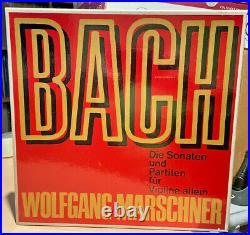
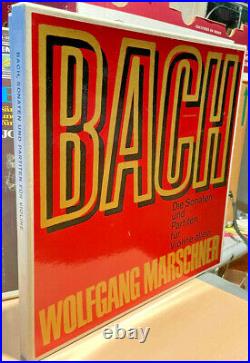
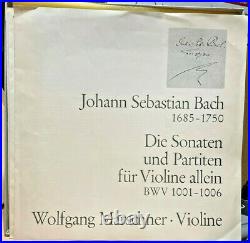
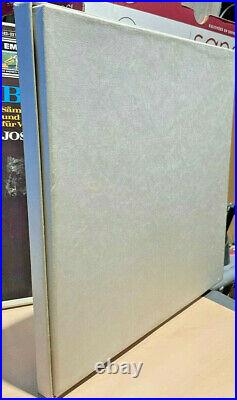
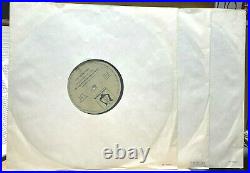
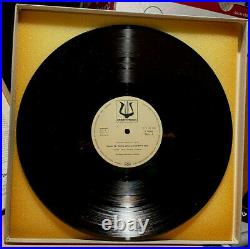
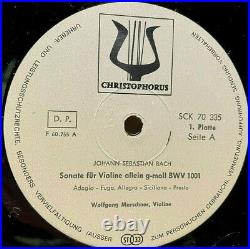
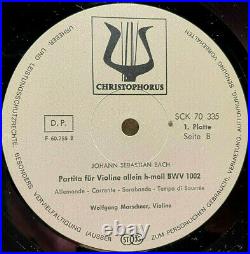

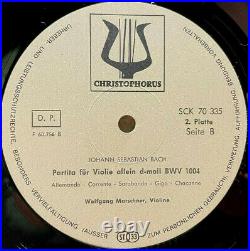
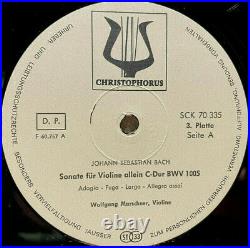


Welcome to our listing, thanks very much for looking! We have lots of out of print LPs and CDs!
Find us on the web at. Please see our other listings - new items added {almost} daily! It's always best to wait for our invoice before paying for your item. The sonatas and partitas for solo violin (BWV 10011006) are a set of six works composed by Johann Sebastian Bach.
They are sometimes referred to in English as the sonatas and partias for solo violin in accordance with Bach's headings in the autograph manuscript: "Partia" (plural "Partien") was commonly used in German-speaking regions during Bach's time, whereas the Italian "partita" was introduced to this set in the 1879 Bach Gesellschaft edition, having become standard by that time. The set consists of three sonatas da chiesa in four movements and three partitas (or partias) in dance-form movements. The 2nd Partita is widely known for its Chaconne, considered one of the most masterly and expressive works ever written for solo violin.The set was completed by 1720 but was not published until 1802 by Nikolaus Simrock in Bonn. Even after publication, it was largely ignored until the celebrated violinist Joseph Joachim started performing these works. Today, Bach's Sonatas and Partitas are an essential part of the violin repertoire, and they are frequently performed and recorded.
The Sei Solo a Violino senza Basso accompagnato (Six Solos for Violin Without Bass Accompaniment), as Bach titled them, firmly established the technical capability of the violin as a solo instrument. The pieces often served as archetypes for solo violin pieces by later generations of composers, including Eugène Ysaÿe and Béla Bartók.
The surviving autograph manuscript of the sonatas and partitas was made by Bach in 1720 in Köthen, where he was Kapellmeister. As Wolff (2002) comments, the paucity of sources for instrumental compositions prior to Bach's period in Leipzig makes it difficult to establish a precise chronology; nevertheless, a copy made by the Weimar organist Johann Gottfried Walther in 1714 of the Fugue in G minor for violin and continuo, BWV 1026, which has violinistic writing similar to that in BWV 10011006, provides support for the commonly held view that the collection could have been reworked from pieces originally composed in Weimar.
The goal of producing a polyphonic texture governed by the rules of counterpoint also indicates the influence of the first surviving works of this kind for solo violin, Johann Paul von Westhoff's partitas for solo violin composed in 1696. The virtuoso violinist Westhoff served as court musician in Dresden from 1674 to 1697 and in Weimar from 1699 until his death in 1705, so Bach would have known him for two years.
The repertoire for solo violin was actively growing at the time: Heinrich Ignaz Franz Biber's celebrated solo passacaglia appeared c. 1676; Westhoff's collections of solo violin music were published in 1682 and 1696; Johann Joseph Vilsmayr's Artificiosus Concentus pro Camera in 1715, and Johann Georg Pisendel's solo violin sonata was composed around 1716; and finally, Georg Philipp Telemann published 12 Fantasias for solo violin in 1735.The tradition of polyphonic violin writing was already well-developed in Germany, particularly by Biber, Johann Heinrich Schmelzer, and the composers of the so-called Dresden school Johann Jakob Walther and Westhoff. Bach's Weimar and Cöthen periods were particularly suitable times for composition of secular music, for he worked as a court musician. Bach's cello and orchestral suites date from the Cöthen period, as well as the famous Brandenburg Concertos and many other well-known collections of instrumental music. In the list of Bach's chamber works, the violin solos form part of a small group, as there is the supposed'libro secundo' of the 6 suites à Violoncello solo, with a single partita for flauto traverso solo, in A minor, placed directly after the cello suites in the Schmieder catalogue: BWV 1013. So there exist in all 13 varied sonatas and partitas in the'senza Basso' group.
In both major manuscripts the important specification is written clearly: for violin/violoncello solo,'senza Basso accompagnato'. Bach himself underwrote the practice of Basso Continuo as the Fundament of Music, which was the common denominator in all artistic music in his time. A solo sonata for violin would naturally have the continuo players and parts implied, here Bach himself tells us that Basso Continuo does not apply. The norm was set by Corelli's important solo sonatas of 1700 op. 5 which may have been accompanied in a variety of ways, but here the Basso Continuo is the natural accompaniment to the'solo' violin. Written is the bass line, with numbers and incidentals to point to desired harmonies that are to be worked out by the harpsichordist or lute player, to which a low register bowed or blown instrument can be added to double the left hand bass line. This was a given, the'senza Basso' pieces are the exception in that they challenge the player to realise various layers wherein some notes and patterns are the accompaniment of other parts, so that a polyphonic discourse is written into the music. Arpeggios over several strings, multiple stopping and opposing tonal ranges and particularly very deft bowing are exploited to the full to make all the voices speak from one bow and four strings, or five, or from a single flute. The sonatas each consist of four movements, in the typical slow-fast-slow-fast pattern of the sonata da chiesa. The first two movements of each sonata are a prelude and a fugue. The third (slow) movement is lyrical, while the final movement shares the similar musical structure as a typical binary suite movement. Unlike the sonatas, the partitas are of more unorthodox design. Although still making use of the usual baroque style of allemande, courante, sarabande, and gigue, with some omissions and the addition of galanteries, new elements were introduced into each partita to provide variety.Wolfgang Marschner (23 May 1926 24 March 2020) was a German violinist, teacher of violin, composer and conductor. He was concertmaster of the WDR Sinfonieorchester Köln, and instrumental in world premieres of contemporary music. He was professor at the Folkwang-Hochschule Essen, the Musikhochschule Köln, the Tokyo University of Fine Arts and Music and, for more than three decades, at the Hochschule für Musik Freiburg. He also taught at the Darmstädter Ferienkurse.
Marschner was born in Dresden in 1926. He came from an old musical family, whose most famous representative was the opera composer Heinrich Marschner. At the age of four he became the youngest member of the orchestra school of the Staatskapelle Dresden. He made his debut playing Tartini's Devil's Trill Sonata at age nine.
He studied from age 14 at the Mozarteum in Salzburg, where, inspired by Váa Píhoda, Clemens Krauss and Ermanno Wolf-Ferrari, he composed his 1. Divertimento for String Quartet under the direction of the First Concertmaster of the Mozarteum Orchestra Salzburg. At the age of barely seventeen, Marschner was drafted into military service. After the end of World War II, he studied in Hamburg with Erich Röhn, concert master of the Berlin Philharmonic.
At the same time, he became soloist, concertmaster and second conductor of the Staatsoper Hannover and played Brahms's Violin Concerto with Franz Konwitschny, who engaged him for further concerts with the Dresden Staatskapelle and the Leipzig Gewandhaus Orchestra. In 1947 he became concertmaster of the WDR Sinfonieorchester Köln, where he played the German premiere of William Walton's Violin Concerto. As a conductor, he led a production of the operetta Ein Walzertraum by Oscar Straus, with the Viennese singer Gretl Schörg. Marschner died in March 2020 at the age of 93.
At the age of twenty-six, Marschner became a professor at the Folkwang-Hochschule Essen and then taught at the Musikhochschule Köln from 1958 to 1963. As primarius of the Cologne String Quartet with Maurits Frank, the cellist of the Amar Quartet, he combined the quartet's worldwide engagements with his tasks as soloist, conductor, composer and pedagogue. He represented the German violin school also as a professor at the Tokyo University of Fine Arts and Music.
He was professor of violin at the Hochschule für Musik Freiburg from 1963 to 1997. Marschner gave master classes in Ankara, Beijing, London, St. Petersburg, Warsaw, Weimar, and in acut Castle in Poland. He was a juror of international competitions, and founded the International Violin Competition "Ludwig Spohr" in Freiburg im Breisgau in 1976.
He founded his own chamber orchestra, the Kammerorchester Wolfgang Marschner, in the 1970s. Marschner founded the Deutsche Spohr Akademie, an international academy for violin, viola and cello, and the Marschner Festival Hinterzarten in 1976, to promote young artists who played chamber music for strings. It included from 1992 a triennial International Marschner Competition for Violin and Viola as well as the International Violin Making and Violin Sound Competition "Jacobus Stainer" initiated by Marschner. Marschner became also director of the Pflüger Foundation which maintains a school for string players until age 16 with a focus on chamber music. Marschner focused on the study of the Second Viennese School around Arnold Schönberg which had been banned in Germany before 1945.He took part in the Darmstädter Ferienkurse from 1954. Marschner's recording of Schoenberg's Violin Concerto with Michael Gielen and the SWR Sinfonieorchester Baden-Baden und Freiburg was critically acclaimed. Other examples of Marschner's involvement with the Second Viennese School include the concerto with the Vienna Symphony Orchestra and Gielen, with the Royal Philharmonic Orchestra under Pierre Boulez in London, with the Tonhalle-Orchester Zürich conducted by Hans Rosbaud, with the Dresden Staatskapelle under Otmar Suitner, with the MDR Sinfonieorchester conducted by Herbert Kegel, with Stockholmers conducted by Herbert Blomstedt, both with the Scottish National Orchestra at the 1959 Edinburgh Festival, which meant the British premiere.
He also played it with the London Symphony Orchestra conducted by Alexander Gibson, with the BBC Symphony Orchestra and Norman Del Mar, and with the Philharmonic Orchestra of the City of Freiburg, which he also conducted himself. Marschner performed Alban Berg's Violin Concerto with the BBC Symphony Orchestra and Bruno Maderna, with the Wiesbaden Symphony Orchestra conducted by Gielen, with the Royal Liverpool Philharmonic Orchestra conducted by Charles Groves, with the hr-Sinfonieorchester under Mario Rossi, with the Radio-Sinfonieorchester Stuttgart conducted by Hans Müller-Kray, and with the RSO Helsinki and Nils-Eric Fougstedt. He performed in Alban Berg's Chamber Concerto for Piano, Violin with 13 Wind Instruments with the Bavarian Radio Symphony Orchestra and soloists Marschner and pianist Carl Seemann, conducted by Paul Hindemith, the Dresden Staatskapelle with Edouard Steuermann and Scherchen, with the Berlin Philharmonic also with Carl Seemann conducted by Werner Egk, with the Paris Symphony conducted by Pierre Boulez, with the Liverpool Philharmonic and Wilfred Parry conducted by John Pritchard and with the Hallé Orchestra Manchester conducted by John Barbirolli.
Marschner played world premieres such as Luigi Nono's Il Varianti in Palermo, violin concertos by Winfried Zillig with Hans Schmidt-Isserstedt in Hamburg, by Bernd Alois Zimmermann in Cologne, by Igor Stravinsky in Cairo, and other works. As a premiere, Marschner performed the revised version of Karl Amadeus Hartmann's Concerto funebre in Braunschweig in 1959 with the local Staatstheaterkapelle conducted by Heinz Zeebe. He first performed works by Karlheinz Stockhausen, beginning with the Sonatine for violin and piano, with the composer as the pianist, in a broadcast as the first public performance of a work by Stockhausen. He also played first performances of works by Pierre Boulez, by Schoenberg's student Eduard Steuermann, by Australian Don Banks whose work was written for him for a Proms performance in 1968, and by Raphaël Cendo. At the Darmstädter Ferienkurse, he played the premiere of Franco Evangelisti's 4!
, Due piccoli pezzi per pianoforte e violino in 1954, and Giacomo Manzoni's Seconda piccola suite per violino e pianoforte with Aloys Kontarsky in 1957. LPs made by CHRISTOPHORUS Records, in.LP is recorded in STEREO. Record Catalog Number: SCK 70 335. Record Labels are primarily WHITE/GRAY with BLACK lettering.
This listing is for a HOLY GRAIL item! A Super Rare, out of print 3-LP Boxed Set - an. OPENED and in near MINT minus overall condition LP PRESSED and ISSUED by CHRISTOPHORUS Records.
Of a highly collectible title from their catalog - a superb title featuring. Bach // Wolfgang Marschner, violin. Sonate Für Violine Allein G-moll Nr. 1 BWV 1001 Adagio - Fuga - Allegro - Siciliana - Presto A2.
Partita Für Violine Allein H-moll Nr. 1 BWV 1002 Allemende - Corrente - Sarabande - Tempo di Bourrée B1. Sonate Für Violine Allein A-moll Nr. 2 BWV 1003 Grave - Fuga - Andante - Allegro B2.
Partita Für Violine Allein D-moll Nr. 2 BWV 1004 Allemende - Corrente - Sarabanda - Giga - Chaconne C1. Sonate Für Violine Allein C-Dur Nr. 3 BWV 1005 Adagio - Fuga - Largo - Allegro assai.
Partita Für Violine Allein E-Dur Nr. 3 BWV 1006 Preludio - Loure - Gavotte en Rondeaux - Menuet I und Menuet II - Bourrée - Gigue. Artwork Herbert Becker Booklet Editor Hermann Bittel Co-producer Westdeutscher Rundfunk Köln Photography By Leif Geiges Recorded By Eduard Ebert, Hermann Rantz Recording Supervisor Klaus-Dieter Harbusch Violin Wolfgang Marschner Christophorus Verlag Freiburg. The outer LP BOX is in. The box has NO splits and NO crushing.
There are NO cutout marks and NO writing on the box. The corners and seams are solid with just some light shelf wear - see our pictures with this listing as they are of the actual item. LPs are in near mint minus overall condition. The LPs are shiny and glossy with NO serious marks evident.
There may be a slight spider mark or two, but we couldn't really see anything when we examined the LPs under strong, white light. The vinyl does have some dust and a finger print or two so they should get a good cleaning before playing for best results. The set comes complete with the paper libretto - this is a superb collectors grade example - it would be very difficult to find a better copy. A Short Note About LP GRADING. Mint {M} = Only used for sealed items.
Near Mint {NM} = Virtually flawless in every way. Near Mint Minus {NM-} = Item has some minor imperfections, some audible. Excellent {EXC} = Item obviously played and enjoyed with some noise.
Very Good Plus {VG+} = Many more imperfections which are noticeable and obtrusive. For best results, always properly clean your LPs before playing them. The LP is an audiophile quality pressing any collector of fine MFSL, half speeds, direct to discs, Japanese/UK pressings etc. Can attest to the difference a quality pressing can make to an audio system.Do not let this rarity slip by! The item "CHRISTOPHORUS 3-LP Box SCK-70-335 Wolfgang MARSCHNER plays J. BACH 1972 DEU" is in sale since Tuesday, February 23, 2021.
This item is in the category "Music\Vinyl Records". The seller is "hearthedifference" and is located in New York, New York. This item can be shipped worldwide.
- Artist: Wolfgang Marschner, J.
Bach
- Country/Region of Manufacture: Germany
- Catalog Number: Christophorus 3-LP Box Set SCK-70-335
- Style: 1970s
- Custom Bundle: No
- Duration: Box Set (3-LPs)
- Inlay Condition: Near Mint (NM or M-)
- Composer: Johann Sebastian Bach
- Record Grading: Near Mint (NM or M-)
- Material: Vinyl
- Instrument: Violin
- Speed: 33 RPM
- Case Type: Cardboard Sleeve
- Record Size: 12"
- Format: Record
- Type: Box Set
- Features: Insert Included
- Record Label: Christophorus
- Fidelity Level: Full-Range
- MPN: SCK-70-335
- Release Year: 1972
- Edition: Collector's Edition
- Genre: Classical
- Number of Audio Channels: Stereo
- Era: 1970s
- Modified Item: No
- Album Name: Bach Die Sonaten & Partiten Für Violine, Marschner
- Sleeve Grading: Excellent (EX)
